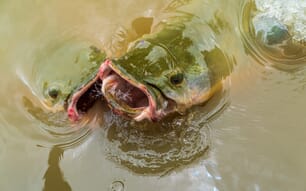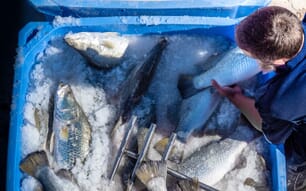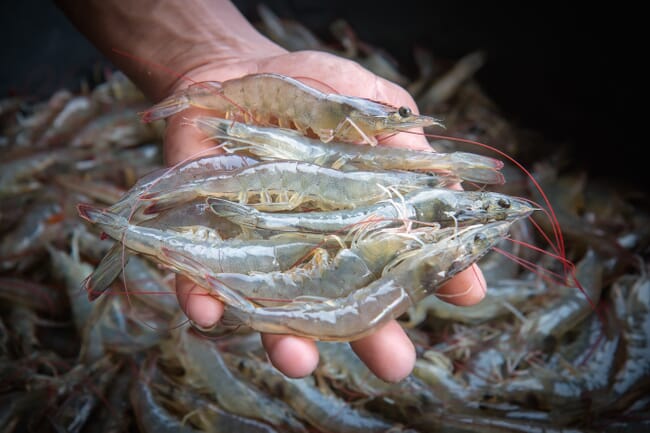
The key to efficient selection for growth in Pacific white shrimp (Litopenaeus vannamei) is the ability to determine how much of the variation that is observed is heritable © Shutterstock
The Pacific white shrimp (Litopenaeus vannamei) is by far the most widely farmed crustacean worldwide, and also the most highly domesticated and genetically selected. Several companies involved in breeding this species have established marketing campaigns offering “improved” lines of shrimp, which are typically focused on two goals: growth rate and/or disease resistance. Some lines in the marketplace are advertised as superior in one aspect or the other, and some are represented as exhibiting above average performance for both growth and resistance.
Names vaguely reminiscent of virility-enhancing products, like “Bolt,” “Kong Power,” and “Turbo Power” from Homegrown Shrimp, “Fire Power” and “Dragon Power” from American Mariculture, and Hendrix Genetics’ “Kona Bay Strength” are all easy to find when searching the internet for high-performing shrimp lines. Many shrimp farming businesses with their own hatcheries are pursuing similar breeding goals on an in-house basis.
Background
Growth is a fairly straightforward goal for any aquaculture operation but, as we evaluate what makes a shrimp superior in terms of resistance, we need to consider how shrimp are farmed. There is increasing interest in indoor RAS culture in some countries, but the vast majority of farmed shrimp are raised in open ponds that are filled and regularly refreshed with surface water from surrounding estuaries, bays and rivers. This becomes an important consideration when evaluating disease resistance in the production environment, because – in spite of the best biosecurity measures – most pathogens eventually find their way into farming operations. Birds, aquatic insects, copepods, barnacles, false mussels and many other organisms have all been implicated in the spread of shrimp diseases from pond to pond and farm to farm.
A recent example involves the microsporidian intracellular parasite Enterocytozoon hepatopenaei (EHP) which can severely limit shrimp growth, inflating feed costs and reducing yields. EHP emerged in Asia and subsequently found its way to the Americas, causing severe economic losses in many shrimp producing countries. Recent work has definitively demonstrated that aquatic insects can infect shrimp with EHP and vice versa (Dewangan et al. 2023). Unless it suddenly becomes economical to cover production ponds with window screen, breeding for resistance to EHP will continue to be a high priority. Biosecurity is also routinely compromised when producers are forced to utilise unfiltered or only partially filtered water. The massive volumes of water required for conventional shrimp farming preclude filtering out pathogens themselves, or even many common pathogen-carrying organisms.
Some purveyors portray the development of improved lines of shrimp as analogous to the development of commercial poultry genetics. This might be the case for growth rates, but an equally realistic analogy based on chickens might be the superiority of backyard survivors over industrial-bred birds, at least in outdoor settings with little control over the environment or the pathogens that might be encountered.
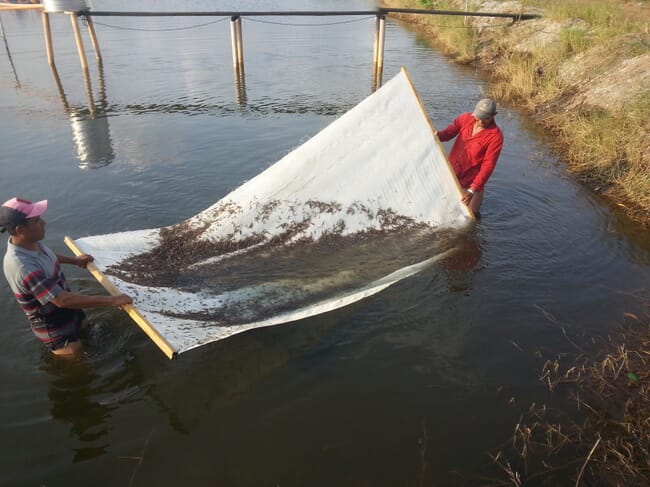
Pacific white shrimp are most vulnerable to many diseases early in the growth cycle, both in the hatchery and also in open ponds where, despite the best biosecurity measures, pathogens can eventually find their way into farming operations © Greg Lutz
How are these ongoing shrimp selection programmes structured? A variety of approaches have merit, including index, multi-trait and tandem selection. Many operations are essentially applying what is known as tandem selection, wherein survival is selected for (with the pathogens’ assistance), followed by a focus on growth. One complicating factor when selecting for both resistance and growth involves controlling for density. If a tank, cage or pond full of shrimp exhibits low survival, stocking density is reduced and individual growth will increase accordingly. This relationship has occasionally been interpreted as a negative genetic correlation between growth and disease resistance – in shrimp and many other aquatic species – but more useful results for selection programmes can be obtained if growth data can be adjusted for density effects.
Genetic attributes developed and expressed under controlled conditions are often obscured in real-world shrimp farming situations. Shrimp that have been bred to exhibit fast growth often require better water quality, optimum nutrition and enhanced oxygen levels to express their superiority, so producers are often left making apples-to-oranges comparisons. The trick is to develop shrimp that can tolerate existing farm conditions (apart from lower feeding rates) and still exhibit faster growth. Some ongoing research is even focused on improving environmental tolerances (Fu and Liu, 2022). A thorough understanding of the balance between a pond’s assimilation capacity, the shrimps’ growth and survival rates, and overall profit margins should be the basis for adopting genetically “improved” strains.
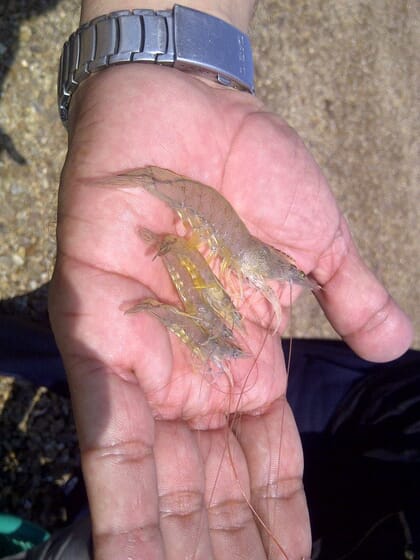
According to Lutz a number of commercially available L. vannamei lines are being represented as resistant to stressors and pathogens, but in some cases resistance to one disease does not necessarily confer resistance to others. © Greg Lutz
The best of both worlds?
One approach which seems to be en vogue these days, as reflected in the offerings of “balanced” varieties of improved shrimp, involves developing separate lines selected for growth and hardiness, then crossing them to capture some portion of the superiority from each. This also, conveniently, results in crossbred animals that produce rather inconsistent results if used as breeding stock by farmers – meaning that shrimp breeders maintain their business with regular sales. Fu et al. (2023) demonstrated the potential benefits from such an approach earlier this year.
Crossing distinct lines also has the benefit of re-setting accumulated inbreeding. A theory was proposed in the mid-2010s that inbreeding depression resulting from spawning highly related shrimp from commercial lines had contributed to disease outbreaks in several parts of the world. However, Castillo-Juarez and his colleagues (2018) demonstrated that elevated inbreeding levels appeared to have negligible effects, if any, on acute hepatopancreatic necrosis disease (AHPND) resistance. In 2015 de los Rios-Perez et al. reported that across a wide range of inbreeding levels (0 percent to 60.4 percent), for every 10 percent increase in inbreeding harvest weight decreased by only 2.19 percent and survival was unchanged.
A number of commercially available L. vannamei lines are being represented as resistant to stressors and pathogens, but in some cases resistance to one disease does not necessarily confer resistance to others. Castillo-Juarez et al. (2018) evaluated the effects of AHPND in a “resistance” line derived from several white spot syndrome virus (WSSV)-resistant strains from Ecuador, and a “growth” line produced through selection at a hatchery in Mexico. Heritabilities (representing the portion of observed superior performance that would be expected to be transmitted to the next generation) for survival time following a challenge with AHPND-causing Vibrio were low, ranging from 0.09 to 0.18. Nonetheless, the observed survival for the “resistance” line was significantly higher than that of the “growth” line, suggesting that prior selection for WSSV resistance may have indirectly improved resistance to AHPND. This could make sense because the immune response of shrimp and other decapods is fairly non-specific.
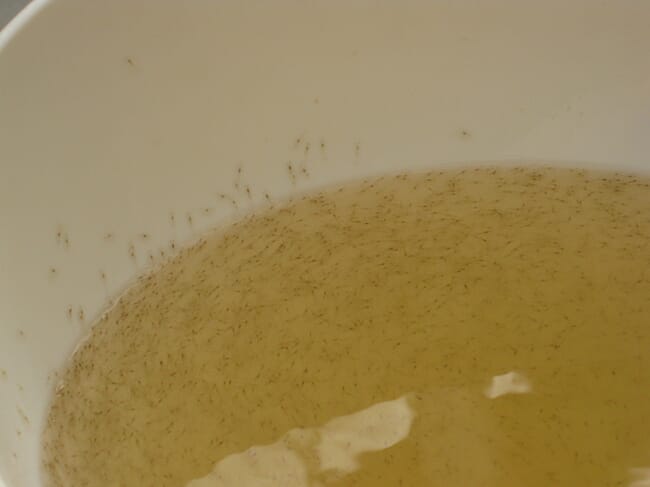
Some shrimp pathogens can be transmitted to larvae within the hatchery © Greg Lutz
However, Veloso et al. (2011) examined gene expression patterns in two strains of L. vannamei [one resistant to taura syndrome virus (TSV) and another susceptible to it] following infection with yellowhead virus (YHV). Although the transcriptomic responses of the two lines to YHV infection were quite different, mortality patterns were similar, with both exhibiting 100 percent mortality by three days post-injection. In a separate study, after examining the effects of infectious myonecrosis virus (IMNV), TSV and WSSV in a specific pathogen-free (SPF) line of L. vannamei, Prochaska et al. (2022) determined that resistance to each of the three diseases was somewhat heritable but genetic resistance to any one disease was not a strong predictor of resistance to the others.
The next phase of improvement
Most traits of commercial importance in shrimp production are under the control of many distinct genes, only a few of which may result in noticeable superiority. Fortunately, the modern discipline of genomic selection allows simultaneous analysis of many hundreds or even thousands of genes throughout an organism’s genome (its entire genetic material) to develop an overall profile. This allows for genome-wide association studies (GWAS) to evaluate relationships between genetic profiles and observed performance. Unfortunately, like most new technologies, acquiring the equipment and expertise required to pursue this approach can be quite expensive.
Beginning in the mid-2000s, high-throughput sequencing allowed researchers to use single-nucleotide-polymorphisms (SNPs) as markers to describe the genes of most importance for specific traits like growth and disease resistance. SNPs simply refer to chromosome locations, associated with gene coding regions, that exhibit variation in a single DNA building block. Santos et al. (2018) identified thousands of specific SNPs that reflected differences in individual Pacific white shrimp with higher and lower growth rates, and also in healthy and unhealthy shrimp exposed to WSSV. Subsequently, a group of researchers used a suite of over 18,000 SNPs to demonstrate the applicability of genomic selection for WSSV resistance in L. vannamei (Lillehammer et al. 2020). After a single generation their selected line exhibited 51 percent survival, compared to 38 percent for a random control line. A commercially available chip now allows for the analysis of some 50,000 SNP locations in the shrimp genome, many of which have already been associated with various traits.
Although genomic methods allow for big-picture assessments of genetic control of important traits, they also provide the opportunity to zoom in on specific genes. A group of researchers in China recently identified SNPs in protein kinase C delta type and ras-related protein Rap-2a genes that were significantly associated with growth rate in two independent L. vannamei populations (Yu et al. 2019). Follow-up studies have identified polymorphisms of LvMMD2associated with body weight and a mutation known as MMD_5 that explained over 10 percent of the observed variation in growth rate (Wang et al. 2020, Lyu et al. 2021).
A number of other studies have been published recently on the use of genomic methods to address disease resistance in shrimp, especially AHPND, and the use of genomic selection offers many new opportunities for improvement of disease resistance in L. vannamei. ShuHui and XiLin (2020) found that genetic diversity of stress resistance markers was significantly higher in wild populations than in domesticated stocks, suggesting that genomic selection will allow for the efficient incorporation of previously overlooked genetic resources into shrimp selection programmes.


